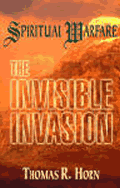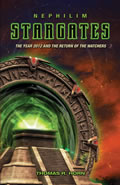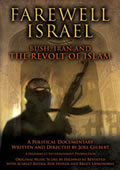READ
IT BEFORE IT'S BANNED BY THE US GOVERNMENT
PART 17
By Thomas R. Horn
August 4, 2009
NewsWithViews.com
THE RISE OF OSIRIS
As the
centuries passed by, the god and goddess worshipping cities of the Sumerians
faded away. The flourishing fields of agriculture that once provided the
underpinnings of the great Sumerian economy were depleted of fertility
through over-irrigation, and residues of salt build-up appeared to chaff
the 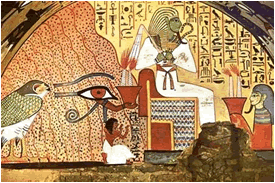 surface
of the land. The city-states of Sumeria; Kish, Ur, Lagash, and Umma, damaged
by a millennium of ruthless infighting among the Sumerians, finally succumbed
to militant external forces. The barbarian armies of the Elamites (Persians)
invaded and destroyed the city of Ur, and Amorites from the west overran
the northern province of Sumer and subsequently established the hitherto
little-known town of Babylon as their capital. By B.C.1840, Hammurabi,
the sixth king of Babylon, conquered the remaining cities of Sumeria and
forged northern Mesopotamia and Sumeria into a single nation. Yet the
ultimate demise of the Sumerian people did not vanquish their ideas. Sumerian
art, language, literature, and especially religion, had been forever absorbed
into the cultures and social academics of the nations surrounding Mesopotamia,
including the Hittite nation, the Babylonians, and the ancient Assyrians.
Ultimately a principal benefactor of Sumeria’s ideas, and a people
who would make their own contributions to the ancient mythologies, was
an old and flourishing population of agrarians known as the Egyptians.
surface
of the land. The city-states of Sumeria; Kish, Ur, Lagash, and Umma, damaged
by a millennium of ruthless infighting among the Sumerians, finally succumbed
to militant external forces. The barbarian armies of the Elamites (Persians)
invaded and destroyed the city of Ur, and Amorites from the west overran
the northern province of Sumer and subsequently established the hitherto
little-known town of Babylon as their capital. By B.C.1840, Hammurabi,
the sixth king of Babylon, conquered the remaining cities of Sumeria and
forged northern Mesopotamia and Sumeria into a single nation. Yet the
ultimate demise of the Sumerian people did not vanquish their ideas. Sumerian
art, language, literature, and especially religion, had been forever absorbed
into the cultures and social academics of the nations surrounding Mesopotamia,
including the Hittite nation, the Babylonians, and the ancient Assyrians.
Ultimately a principal benefactor of Sumeria’s ideas, and a people
who would make their own contributions to the ancient mythologies, was
an old and flourishing population of agrarians known as the Egyptians.
By the year B.C. 1350, Egyptian dominance had spread from Syria and Palestine into the farthest corners of the Fertile Crescent. From northern Mesopotamia to the Baltic Sea, the pharaohs of Egypt had established themselves as the social and economic leaders of the civilized world, ruling an area more than 2,000 miles in length. The military superiority of the Egyptian army demonstrated the ability to subdue the threat of resistance, maintaining a hegemony that extended from the Nubians to the Hyksos. Even so, in the final analysis, it was the influence of the gods of Egypt—with their magic, myths, and rituals—that provided the Egyptians a lasting place in history and led succeeding generations into an immense, enlightening description of the ancient mythologies, including a wealth of information regarding the dynamics and supernatural possibilities of paganism.
Prehistoric Egyptians believed in the same fundamental idea that most evolutionists subscribe to today—the premise that the oceans both preceded and in some way contributed to the creation of the living cosmos. From the Fifth Dynasty Pyramid Texts, the Heliopolitan theory of creation stated that Atum (the sun god Ra) independently created himself from a singular expression of self will—an act visualized by the Egyptians as a divine egg that appeared upon the primordial waters of the all-filling ocean called Nun, out of which Atum (meaning He who created himself), emerged. According to myth, a second act of creation developed around a divine masturbation when Atum, the great "He-She," orally copulated himself and afterward regurgitated his children—Shu and Tefnut—who assumed the positions of god and goddess of air and moisture. Later, when Shu and Tefnut became lost in the universal ocean of Nun, Atum exhibited his paternal care by sending out his Eye, which had the curious habit of detaching itself from Atum and of thinking independent thoughts, to look for them. The Eye of Atum succeeded in finding the child gods and eventually returned to discover that Atum had grown impatient during the wait and had created a second eye. In order to placate the hostility that soon developed between the two divine eyes, Atum affixed the first eye upon his forehead where it was to oversee and rule the forthcoming world of creation. Thus the Eye of Atum became the jealous, destructive aspect of the sun god Ra.
To avoid getting lost again in the all-filling waters of Nun, Shu and Tefnut procreated Geb (the earth), and Nut (the sky), and thus provided the more stable elements of earth, nature, and the seasons. Later, Geb was conceptualized as cohabiting with Nut and producing four children of his own: Seth, Osiris, Isis, and Nephthys. Of these, Osiris and Isis grew into such powerful cult deities that Osiris, with the help of his sister-wife Isis, nearly overthrew Ra as the most powerful of the gods—an action that so enraged his brother Seth that the hateful and jealous sibling killed him. Seth’s murderous act was followed by the jackal-headed god, Anubis, assisting Isis with the embalming of her slain husband-brother Osiris, an act through which Anubis secured his position as "the god of embalming." Then, while still in mourning, Isis summoned the wisdom of Thoth, which she combined with her own proficient magical skills, and produced a resurrected Osiris, who, in turn, impregnated her with Horus, the god of daylight. Horus promptly avenged his father’s death by killing the evil brother Seth.
Another version of the myth claims that Horus was born to Isis only after she impregnated herself with semen that she had taken from the corpse of Osiris (activity that sounds suspiciously like advanced science, artificial insemination or cloning). The god Seth was angry and sought to destroy Horus, and Ufologists may note with interest how Isis seeks help from Thoth, who comes in a flying craft—the Boat of the Celestial Disc—as recorded in the Metternich Stela:
Then Isis sent forth a cry to heaven and addressed her appeal to the Boat of Millions of Years. And the Celestial Disc stood still, and moved not from the place where it was. And Thoth came down, and he was provided with magical powers, and possessed the great power… And he said: ‘O Isis, thou goddess, thou glorious one… I have come this day in the Boat of the Celestial Disc from the place where it was yesterday… I have come from the skies to save the child for his mother.
Yet another story claims that Seth persuaded his brother Osiris to climb into a box, which he quickly shut and threw into the Nile. Osiris drowned and his body floated down the Nile river where it snagged on the limbs of a tamarisk tree. In Byblos, Isis recovered the body from the river bank and took it into her care. In her absence, Seth stole the body again and chopped it into fourteen pieces, which he threw into the Nile. Isis searched the river bank until she recovered every piece, except for the genitals, which had been swallowed by a fish (Plutarch says a crocodile). Isis simply replaced the missing organ with a facsimile and was somehow able to reconstruct Osiris and impregnate herself with the ithyphallic corpse.
From this time forward Osiris was considered the chief god of the deceased and the judge of the netherworld—the dark and dreary underworld region of the dead. In human form Osiris was perceived as a mummy and, paradoxically, while he was loved as the guarantor of life after death, he was feared as the demonic presence that decayed the bodies of the dead. Such necromantic worship of Osiris grew to become an important part of several Mediterranean religions, with his most famous cult center being at Abydos in Upper Egypt where an annual festival reenacted his death and resurrection. In Abydos, Osiris was called the god of the setting sun—the mysterious "force" that ruled the region of the dead just beneath the western horizon. He was venerated in this way primarily because death, and specifically the fear of one’s estate after death, grew to constitute so much of Egyptian concern.
In the funerary texts known as the Book of the Dead, the most elaborate magical steps were developed around the Osiris myth to assist the Egyptians with their journey into the afterlife. It was believed that every person had a Ka—a spiritual and invisible duplicate—and that the Ka accompanied them throughout eternity. Since the Ka provided each person with a resurrected body in the kingdom of the dead, yet could not exist without the maintenance of the earthly body, every effort was made to preserve the human corpse. The body was therefore mummified according to the elaborate magic rituals passed down from Isis, who, according to legend, singularly perfected the rituals of mummification through her work on Osiris. Wooden replicas of the body were also placed in the tomb as a kind of substitute in case the mummy was accidently destroyed, and additional protection for the corpse was provided through the construction of ingenious burial tombs specifically designed to hide and preserve the human body for all of eternity. Finally, curses were placed throughout the tomb as a warning to intruders.
At death the Egyptian Ka departed the human body and, accompanied by the hymns and prayers of the living, used the formulas memorized from the funerary texts to outsmart the horrible demons seeking to impede the Ka’s progress into the kingdom (or hall) of Osiris. Arriving at the judgment hall, the heart of the Ka was "weighed in the balance" by Osiris and his 42 demons. If they found the deceased lacking in virtue, he was condemned to an eternity of hunger and thirst. If the Ka was determined to have belonged to an outright "sinner", it was cut to pieces and fed to Ammit—the miserable little goddess and "eater of souls." But if the deceased was judged to have lived a virtuous life, the Ka was granted admittance to the heavenly fields of Yaru, where foods were abundant and pleasures unending. The only toil in this heaven was to serve in the grain fields of Osiris, and even this could be obviated by placing substitutionary statues, called shawabty, into the tomb.
There
is some evidence that the 42 demons or "judges" of Osiris were
in some way related to the prehistoric Watchers—the mysterious
angelic beings who first appeared in the early cultures of the Middle
East (discussed later). The early Egyptian scribes viewed the leaders
from among these fallen Watchers as the underworld demons of Osiris whose
"terrible knives" exacted judgment upon the Ka of the wicked.
The Egyptians were desperately afraid of the netherworld Watchers, and
a significant amount of time was spent determining how to placate the
judgment of Osiris and his 42 demons. The worship of Isis—the sister-wife
of Osiris—thus became integral. As pointed out earlier, Isis was
one of the most important goddesses of ancient mythology and was venerated
by the Egyptians, Greeks, and Romans, as the "goddess of a thousand
names" and as the undisputed queen of magical skills. An example
of her form of magic is found in the Theban Recension of the
Book of the Dead and depicts Isis providing a spell for controlling
the 42 demons of Osiris. The formula consisted of an amulet made of carnelian
that had been soaked in the water of ankhami flowers. It was supposed
to be placed around the neck of the dead person in combination with the
spoken words of magic. If performed properly, it would empower the Ka
of the individual to enter into the region of the dead under the protection
of Isis, where the Ka would thereafter move about wheresoever it wanted
without fear of the 42 demons of Osiris. The only Egyptian who did not
benefit from this particular spell was the Pharaoh, and for a very good
reason. Although Pharaoh was considered to be the "son of the sun
god" (Ra) and the 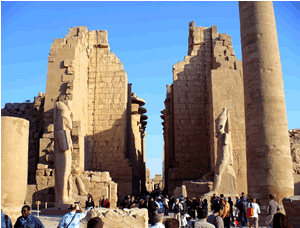 incarnation
of the falcon god Horus during his lifetime, at death he became the Osiris—the
divine judge of the netherworld. On earth, Pharaoh’s son and predecessor
would take his place as the newly anointed manifestation of Horus, and
thus each new generation of the pharaohs provided the gods with a divine
spokesman for the present world and for the afterlife.
incarnation
of the falcon god Horus during his lifetime, at death he became the Osiris—the
divine judge of the netherworld. On earth, Pharaoh’s son and predecessor
would take his place as the newly anointed manifestation of Horus, and
thus each new generation of the pharaohs provided the gods with a divine
spokesman for the present world and for the afterlife.
The observant reader may wonder, "was there something more to the Pharaoh’s deification than meets the eye?" The cult center of Amun-Ra at Thebes may hold the answer, as it was the site of the largest religious structure ever built—the temple of Amun-Ra at Karnak—and the location of many extraordinary magical rituals.
The great Temple with its 100 miles of walls and gardens (the primary object of fascination and worship by the nemesis of Moses—the Pharaoh of the Exodus, Ramses II) was the place where each pharaoh reconciled his divinity in the company of Amun-Ra during the festival of Opet. The festival was held at the Temple of Luxor and included a procession of gods carried on barges up the Nile river from Karnak to the Temple. The royal family accompanied the gods on boats while the Egyptian laity walked along the shore, calling aloud and making requests of the gods.
|
Subscribe to the NewsWithViews Daily News Alerts! |
Once at Luxor, the Pharaoh and his entourage entered the holy of holies where the king joined his ka (the mysterious science or ritual is unknown) and transmogrified into a living deity, the son of Amun-Ra. Outside, large groups of dancers and musicians waited anxiously. When the king emerged ‘transformed,’ the crowd erupted in gaiety. From that day forward the Pharaoh was considered to be—just as the god ciphered in the Great Seal of the United States will be—the son and spiritual incarnation of the Supreme Deity. The All-Seeing Eye of Horus/Apollo/Osiris above the unfinished pyramid on the Great Seal represents this spirit... and prophecies his coming during the Novus Ordo Seclorum.
[See the U-Tube clip of: Apollyon Rising 2012: The Lost Symbol Found and the Final Mystery of the Great Seal Revealed]
[Editor's note: This series is based on research contained in Tom Horn's upcoming new book: APOLLYON RISING 2012: The Final Mystery Of The Great Seal Revealed. Sign up to be notified when APOLLYON RISING 2012 is released and get $60.00 IN FREE GIFTS! Sign up here!]
Click here for part -----> 1, 2, 3, 4, 5, 6, 7, 8, 9, 10, 11, 12, 13, 14, 15, 16,
Sign
Up For Free E-Mail Alerts
E-Mails are used strictly for
NWVs alerts, not for sale
Thomas Horn is the CEO of RaidersNewsNetwork.com and SurvivorMall.com.
Over the last decade, he has authored three books, wrote dozens of published editorials, and had several feature magazine articles. In addition to past articles at NewsWithViews.com , his works have been referred to by writers of the LA Times Syndicate, MSNBC, Christianity Today, Coast to Coast, World Net Daily, White House Correspondents and dozens of newsmagazines and press agencies around the globe. Tom's latest book is "The Ahriman Gate," which fictionalizes the use of biotechnology to resurrect Biblical Nephilim.
Thomas is also a well known radio personality who has guest-hosted and appeared on dozens of radio and television shows over the last 30 years, including "The 700 Club" and "Coast to Coast AM." When looking for a spokesperson to promote their film "Deceived" staring Louis Gossett Jr. and Judd Nelson, "Cloud 10 Pictures" selected Thomas as their spokesperson to explain the Christian viewpoint on UFO-related demonology.
Web Site: RaidersNewsNetwork.com
E-Mail: RaidersNewsUpdate@gmail.com


